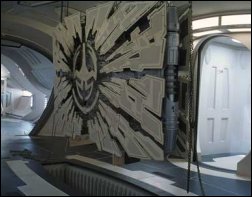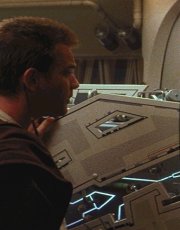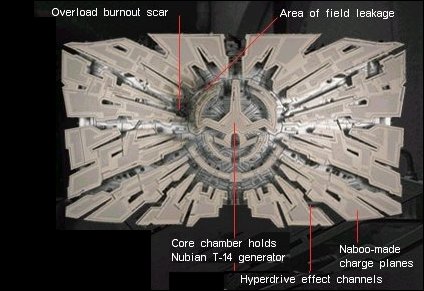| HYPERDRIVES |
| [I noticed earlier the hyperdrive motivator has been damaged. It's impossible to go to lightspeed!] |
| Database: Technology: Ship-based |
| 19 AE | Hyper 02 |
| Type: T-14 hyperdrive generator Manufacturer: Nubian |
| Technology Main | Hyperspace - Hyperdrives | Hyperspace booster | Hyperspace beacon |
| George Lucas refrained from putting an in-cockpit view of a jump to hyperspace in the prequel trilogy as he wanted to save the effect for the classic films |
| Links: Jump to Hyperspace |
| Aside from space travel itself, the ability to enter hyperspace through a hyperdrive engine was perhaps the most important technological advancement in galactic history. It provided everyone with the chance to visit millions of worlds in the blink of an eye. First developed 25,000 years before the Galactic Civil War, hyperdrives were pivotal in the expansion of the Republic. The Core World colonists were able to incorporate more and more star systems under the Republic banner thanks to the hyperdrive, though at that time, the technology was still primative. Little of the galaxy had been explored, and hyperspace jumps were carefully controlled. Pilots would use hyperspace beacons and jump points to travel through specific routes, leaving it to expert explorers to uncover new worlds. As technology progressed, hyperspace jumps were plotted through an astrogation computer, with the destination being fed into the hyperdrive, which then calculated the safest route. Calculations complete, the hyperdrive motivator was engaged. The motivator was responsible for initiating the thrust needed to enter hyperspace, as well as the side-step out of realspace. It was an integral part of the hyperdrive engine, as it also fine-tuned the engines while in hyperspace, making thrust adjustments needed to navigate. The safe reversion into realspace at the end of a journey was also handled by the hyperdrive motivator. Hyperdrives were classed by their hyperspace multiplier; the lower the better. The numbering was based on a standard time/distance measure that equated to Class One. A drive that took twice the standard time was Class Two - the standard speed of a New Republic civilian transport. Many ships had various jury-rigged upgrades added to make their hyperspace trips even shorter: the Millennium Falcon, for example, was fitted with a Class 0.5 hyperdrive, making it faster than an Imperial starship. However, Han Solo had to be constantly watchful in case his modifications broke down. Ships could not enter hyperspace if it was in the presence of a gravitational force that created a hyperspatial mass shadow. Thus, hyperdrives could not be engaged in the atmosphere of a planet, nor in orbit around one. If a mass shadow was detected, an automatic cut-off would kick-in, and the hyperdrive would drop the ship back into realspace. Many organizations, from space pirates to the Galactic Empire, used this safety feature to their advantage. By creating an artificial gravity-well, or blocking a hyperspace route with a mass shadow, they could yank ships out of hyperspace, and set upon them before their pilot knew what had happened. |
 |
 |
 |